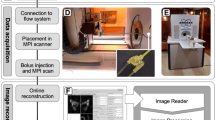Abstract
Volume rendering (VR) is a technique commonly used for the reconstruction of three-dimensional (3D) digital subtraction angiography (DSA) images, and the rendering parameters greatly affect the characteristics of the 3D image. This study aimed to test whether the optimal VR parameters for 3D DSA could be estimated from the contrast effects in rotational two-dimensional (2D) DSA images acquired using 3D DSA. Simulated blood vessels filled with various concentrations of contrast medium were scanned, and the 3D DSA data sets were reconstructed. The syngo AX vessel analysis software that was able to analyze 3D DSA VR image was used for objective measures. Raw data projection images of the 3D DSA data sets in which the mean diameter was calculated as a true value by the software at nine different thresholds for vessel segmentation were selected. In each image set, five images of all 133 rotational 2D DSA images were selected, and the contrast-enhanced area was extracted using a region-growing algorithm. Mean values and standard deviations of each contrast-enhanced area were calculated, and as the thresholds for vessel segmentation of the software increased by 500 every time, significant differences were observed in the mean values (P < 0.01). This optimal threshold can be applied to the window settings of the VR technique. Therefore, the optimal VR parameters for 3D DSA may be determined by analyzing the contrast effects of the raw data projection images, and user-dependent over- and underestimations of 3D DSA VR images also may be prevented.



Similar content being viewed by others
References
Wong SC, Nawawi O, Ramli N, Abd Kadir KA: Benefits of 3D rotational DSA compared with 2D DSA in the evaluation of intracranial aneurysm. Acad Radiol 19:701–707, 2012
Luo B, Yang X, Wang S, Li H, Chen J, Yu H, Zhang Y, Zhang Y, Mu S, Liu Z, Ding G: High shear stress and flow velocity in partially occluded aneurysms prone to recanalization. Stroke 42:745–753, 2011
Leng LZ, Rubin DG, Patsalides A, Riina HA: Fusion of intraoperative three-dimensional rotational angiography and flat-panel detector computed tomography for cerebrovascular neuronavigation. World Neurosurg 79:504–509, 2013
Sun G, Ding J, Lu Y, Li M, Li L, Li GY, Zhang XP: Comparison of standard- and low-tube voltage 320-detector row volume CT angiography in detection of intracranial aneurysms with digital subtraction angiography as gold standard. Acad Radiol 19:281–288, 2012
Lescher S, Samaan T, Berkefeld J: Evaluation of the pontine perforators of the basilar artery using digital subtraction angiography in high resolution and 3D rotation technique. Am J Neuroradiol 35:1942–1947, 2014
Ide S, Hirai T, Morioka M, Kai Y, Yano S, Kawano T, Tochihara S, Shigematsu Y, Uetani H, Murakami Y, Watanabe K, Yamashita Y: Usefulness of 3D DSA-MR fusion imaging in the pretreatment evaluation of brain arteriovenous malformations. Acad Radiol 19:1345–1352, 2012
Serafin Z, Strześniewski P, Lasek W, Beuth W: Follow-up after embolization of ruptured intracranial aneurysms: a prospective comparison of two-dimensional digital subtraction angiography, three-dimensional digital subtraction angiography, and time-of-flight magnetic resonance angiography. Neuroradiology 54:1253–1260, 2012
Kucukay F, Okten RS, Tekiner A, Dagli M, Gocek C, Bayar MA, Cumhur T: Three-dimensional volume rendering digital subtraction angiography in comparison with two-dimensional digital subtraction angiography and rotational angiography for detecting aneurysms and their morphological properties in patients with subarachnoid hemorrhage. Eur J Radiol 81:2794–2800, 2012
Gölitz P, Struffert T, Ganslandt O, Saake M, Lücking H, Rösch J, Knossalla F, Doerfler A: Optimized angiographic computed tomography with intravenous contrast injection: an alternative to conventional angiography in the follow-up of clipped aneurysms? J Neurosurg 117:29–36, 2012
Lu L, Zhang LJ, Poon CS, Wu SY, Zhou CS, Luo S, Wang M, Lu GM: Digital subtraction CT angiography for detection of intracranial aneurysms: comparison with three-dimensional digital subtraction angiography. Radiology 262:605–612, 2012
Fishman EK, Ney DR, Heath DG, Corl FM, Horton KM, Johnson PT: Volume rendering versus maximum intensity projection in CT angiography: what works best, when, and why. Radiographics 26:905–922, 2006
Calhoun PS, Kuszyk BS, Heath DG, Carley JC, Fishman EK: Three-dimensional volume rendering of spiral CT data: theory and method. Radiographics 19:745–764, 1999
Author information
Authors and Affiliations
Corresponding author
Rights and permissions
About this article
Cite this article
Takagi, S., Tokumitsu, H. & Sanada, S. Relationship Between the Contrast Effects of Raw Data Projection Images from Three-Dimensional Digital Subtraction Angiography and the Optimal Volume Rendering Parameters. J Digit Imaging 28, 368–372 (2015). https://doi.org/10.1007/s10278-014-9745-5
Published:
Issue Date:
DOI: https://doi.org/10.1007/s10278-014-9745-5




